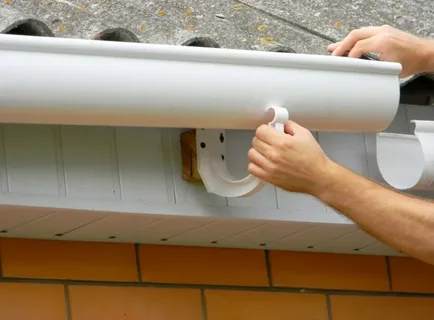Gutters play a critical role in protecting your home from water damage by directing rainwater away from your roof, walls, and foundation. However, over time, gutters can sag, pull away, or detach entirely due to various factors such as weather, debris, or improper installation. Left unattended, sagging or detached gutters can cause water to overflow, damage your home’s exterior, lead to foundation issues, and even cause mold growth.
If you notice your gutters are sagging or pulling away, it’s essential to address the problem promptly. This step-by-step guide will walk you through how to fix sagging or detached gutters, helping you maintain your home’s protection and curb appeal.
Signs You Need to Fix Your Gutters
Before diving into the repair process, it’s important to identify if your gutters need attention. Common signs include:
- Visible Sagging: Sections of gutters droop or pull away from the house.
- Water Overflow: During rain, water spills over the sides instead of flowing through the downspouts.
- Detached Gutters: Gutters completely separate from the fascia or roofline.
- Rust or Holes: Corrosion or holes in the gutter material.
- Pooling Water Near Foundation: Water collects near the home’s base, indicating poor drainage.
- Loose or Missing Fasteners: Screws or hangers that hold gutters in place are loose or missing.
If you spot one or more of these issues, it’s time to fix your gutters.
Tools and Materials You’ll Need
Before starting repairs, gather the following tools and materials:
- Ladder (make sure it’s sturdy and tall enough)
- Work gloves
- Safety glasses
- Tape measure
- Screwdriver or drill
- Replacement gutter hangers or brackets
- Screws or nails (galvanized to prevent rust)
- Gutter sealant or caulk
- Level
- Hacksaw (if cutting new gutters)
- Wire brush or sandpaper
- Bucket or tarp (for debris)
- Garden hose (for testing drainage)
Having these ready will ensure your repair goes smoothly.
Step 1: Safety First
Always prioritize safety when working on gutters. Set up your ladder on stable, level ground. Avoid overreaching—move the ladder as needed to keep yourself balanced. Wear gloves and safety glasses to protect from sharp edges and debris.
Step 2: Clean the Gutters
Remove all leaves, twigs, and debris from the gutters and downspouts. Use a scoop or your hands (with gloves) to clear out the material. Flush the gutters with a garden hose to ensure water flows freely through the system and identify any clogs.

Cleaning is essential before repair to provide clear access and ensure your fix will be effective.
Step 3: Inspect the Gutters and Fasteners
Carefully examine the gutters and the fasteners that hold them in place. Check for:
- Loose, bent, or missing screws and hangers
- Rust spots or holes
- Sagging areas where the gutter has pulled away from the fascia
- Damage to the fascia board itself
Note the problem areas to focus your repair work.
Step 4: Tighten or Replace Fasteners
Often, sagging gutters result from loose or missing fasteners. Use your screwdriver or drill to tighten any loose screws or nails. If fasteners are missing or damaged, replace them with new gutter hangers or brackets spaced about every 24 to 36 inches along the gutter.
For heavy-duty support, consider using fascia hangers that attach to the roof rafters, providing a stronger hold.
Step 5: Realign Sagging Gutters
If gutters have sagged, they may need to be realigned to restore proper slope and drainage. Gutters should slope about 1/4 inch for every 10 feet towards the downspout to ensure water flows correctly.
Use a level to check the pitch, then gently lift or lower sections of the gutter while adjusting the fasteners or hangers to hold the proper angle.
Step 6: Seal Leaks and Holes
Use gutter sealant or caulk to seal any cracks or holes in the gutters. Clean the area with a wire brush or sandpaper before applying the sealant for better adhesion. Follow the manufacturer’s instructions on drying times.
If holes are large or the gutter section is extensively damaged, consider replacing that section.
Step 7: Replace Damaged Sections
For gutters that are severely bent, rusted, or detached, replacement may be necessary. Measure the length of the damaged section, cut a new piece from a gutter supply, and install it in place. Use connectors and sealants to join sections securely.
Make sure the new piece maintains the correct slope.
Step 8: Secure Downspouts
Downspouts are vital for directing water away from your foundation. Check that downspouts are firmly attached and free of clogs. Secure them to the house with brackets, and make sure the water discharges at least 3 to 4 feet away from your home.
If necessary, install downspout extensions or splash blocks to prevent erosion near the foundation.
Step 9: Test Your Repairs
Once all repairs are complete, test your gutters by running water through them with a hose. Watch for any leaks, pooling, or overflow. Make sure water flows smoothly toward the downspouts.
If you spot any issues, adjust fasteners or seal leaks as needed.
Tips to Prevent Future Gutter Problems
- Regular Cleaning: Clean gutters at least twice a year to prevent clogs.
- Install Gutter Guards: These reduce debris buildup, lowering maintenance.
- Trim Nearby Trees: Prevent leaves and branches from falling into gutters.
- Inspect After Storms: Check gutters for damage after heavy winds or ice storms.
- Maintain Fascia and Roof Edges: Damaged fascia boards can weaken gutter support.
Routine maintenance extends the life of your gutters and protects your home.
When to Call a Professional
While many gutter repairs can be DIY projects, certain situations warrant professional help:
- Extensive gutter damage requiring full replacement
- Persistent sagging despite repairs
- Complex rooflines or difficult access
- Foundation or water damage due to gutter failure
- Safety concerns about ladder or roof work
A professional roofing and gutter company will have the tools and expertise to ensure long-lasting repairs.
Conclusion
Sagging or detached gutters can lead to costly home damage if ignored. With this step-by-step guide, you can confidently inspect, clean, repair, and maintain your gutters to keep your home safe and dry. Remember to work safely, use the right tools, and keep up regular maintenance.

If you face more significant gutter issues or prefer expert assistance, don’t hesitate to contact the professionals.
About Atlas Roofing & Restoration
At Atlas Roofing & Restoration, we specialize in comprehensive roofing and gutter services tailored to protect your home. Our experienced team provides expert gutter repairs, replacements, and maintenance, ensuring your gutters perform flawlessly through every season. From minor fixes to full gutter system installations, we’re dedicated to delivering quality workmanship and exceptional customer service.If you need reliable help fixing sagging or detached gutters, reach out to Atlas Roofing & Restoration for trusted solutions that safeguard your home for years to come.




